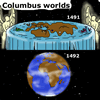When an organism's environmental conditions change such that their death rate continues to exceed their birth rate, extinction of the species is inevitable.
It is estimated that about fifty species per day are becoming extinct due to environmental degradation (e.g. clearing of tropical rainforest and draining of wetlands). This creates imbalances in food chains within delicate ecosystems, and interrupts life cycles.
Current conservation practices
Studies of evidence relating to recent extinctions (such as the Tasmanian
Tiger or Thylacine) may lead to greater understanding and wiser planning
to prevent similar consequences recurring.
Nowadays, the preparation of an environmental impact statement is essential
for any new developments or mining project. Also conservation of specific
habitats in national parks and wilderness areas aims to maintain natural
environmental conditions essential for survival of endangered species.
Zoos, and herbariums, now take a more proactive role in wildlife conservation
of animals and plants.
Thylacine
 The Thylacine's decline resulted from settlers clearing land and
running introduced sheep which the carnivorous Thylacine took for a new
food source! Organised eradication (bounty hunting) was commenced because
of this unwanted predation. Similarly the dodo fell easy prey to humans.
Now it's too late: they are both extinct.
The Thylacine's decline resulted from settlers clearing land and
running introduced sheep which the carnivorous Thylacine took for a new
food source! Organised eradication (bounty hunting) was commenced because
of this unwanted predation. Similarly the dodo fell easy prey to humans.
Now it's too late: they are both extinct.
 Extinction of many other organisms particularly plant, insect, frog
and bird species, is attributable to more indirect and less obvious human
practices. Humans' impact on the environment (see Impact
on environment: Human) in turn affects availability of food, nesting
sites and protective shelter, and causes direct poisoning through pollution.
Extinction of many other organisms particularly plant, insect, frog
and bird species, is attributable to more indirect and less obvious human
practices. Humans' impact on the environment (see Impact
on environment: Human) in turn affects availability of food, nesting
sites and protective shelter, and causes direct poisoning through pollution.
Dinosaurs
 The existence of dinosaurs has only been known since 1840 when Sir
Richard Owen discovered fossil bones of these "terrible lizards"
in England. Our considerable knowledge today is inferred only from fossil
evidence. Teeth structure reflects diet, bones and imprints tell us size,
stance, body structure, mode of locomotion and so on.
The existence of dinosaurs has only been known since 1840 when Sir
Richard Owen discovered fossil bones of these "terrible lizards"
in England. Our considerable knowledge today is inferred only from fossil
evidence. Teeth structure reflects diet, bones and imprints tell us size,
stance, body structure, mode of locomotion and so on.
Why did these prolific and successful animals die out?
Let's first discuss how scientists find out such answers!
 On the basis of observations, scientists construct an hypothesis
(an educated guess). Predictions based on this hypothesis (e.g. "if
this is true, then I'd expect...") suggest further experimentation,
or exploration to look for "missing pieces of the puzzle". If,
after further testing, the hypothesis is still undisputed, a theory is
constructed, though "scientific truth" or "fact" can
never be proven - only disproven. A theory is "the best explanation
we have, given the evidence currently available". Theories can change
dramatically with new evidence (what did Columbous do to test the "world
is flat" theory?)
On the basis of observations, scientists construct an hypothesis
(an educated guess). Predictions based on this hypothesis (e.g. "if
this is true, then I'd expect...") suggest further experimentation,
or exploration to look for "missing pieces of the puzzle". If,
after further testing, the hypothesis is still undisputed, a theory is
constructed, though "scientific truth" or "fact" can
never be proven - only disproven. A theory is "the best explanation
we have, given the evidence currently available". Theories can change
dramatically with new evidence (what did Columbous do to test the "world
is flat" theory?)
Hypotheses for the dinosaurs' extinction
Some hypotheses for dinosaurs' extinction include:
- Dinosaurs ran out of food: reduction in photosynthesis (plant growth)
occurred affecting herbivore diet possibly due to:
- Reduced light caused by a large meteorite hitting the Earth creating
dust clouds which blocked out the sunlight. As the herbivores died
from lack of plants to eat, so the carnivores died from starvation
as well.
- Harmful radiation from a comet or distant exploding star clusters.
- Climatic changes caused by massive volcanic eruptions, meteorite
dust clouds or shifting land masses lowering the planet's temperature.
- Reduced light caused by a large meteorite hitting the Earth creating
dust clouds which blocked out the sunlight. As the herbivores died
from lack of plants to eat, so the carnivores died from starvation
as well.
- Dinosaurs, being ectothermic (cold-blooded), could not adapt to the
cold
of the Ice Ages.
- Predation by larger dinosaurs caused the extinction of the smaller ones leaving nothing to feed on (especially applicable to organisms with long life cycles).
More evidence such as plant fossils from the same geological time might help support one particular hypothesis. However, the "truth" is unknown.
| Copyright owned by the State of Victoria (Department of Education and Early Childhood Development). Used with Permission. |